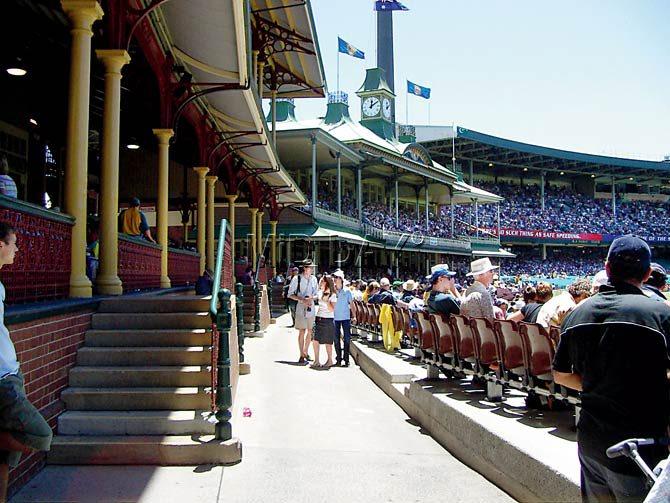While India is looked upon with more respect than ever before, this is the time for our sporting edifices to match up with the best

 Controversy is to Indian cricket what ball is to bat. Without it, there is no game.
Controversy is to Indian cricket what ball is to bat. Without it, there is no game.
The exciting build-up to the ICC World T20 took a massive beating when the ruling party in Himachal Pradesh refused to guarantee the safety of the Pakistani team and the India vs Pakistan tie had to be shifted from Dharamsala to Kolkata.
ADVERTISEMENT

Spectators at the Australia vs Pakistan Test at the Sydney Cricket Ground in January 2005. Pic/Clayton Murzello
Whether Dharamsala would have been incident-free or not, it may be worth questioning why such a high profile, mother of all cricketing battles was scheduled in Dharamsala in the first place? The Himachal Pradesh Cricket Association may boast of one of the most beautiful stadiums in world cricket and it certainly is, but is that a good enough reason to allow it to host a clash which ought to be witnessed by the maximum number of spectators? If the Cricket Association of Bengal were — as they are now — confident of conducting the big game smoothly, it should have been originally scheduled at the Eden Gardens. Would an England vs Australia World Cup clash be held in Chester le Street or Hobart? Would New Zealand play Australia in a World Cup in Hamilton?
It is also strange that Mumbai, the cricketing capital of India, gets to host an India match only if Mahendra Singh Dhoni & Co reach the semi-finals.
Another aspect where India lags behind is spectator-comfort. Only recently it was reported how spectators wanting to watch the warm-up match between Scotland and Zimbabwe in Jamtha had to return to Nagpur city if they wanted to buy tickets, which were only sold at the old Vidarbha Cricket Association ground.
Does anybody care about the spectator in this cricket-mad nation? Unfortunately, very few administrators do. Another example of poor administration at Nagpur was cited by this newspaper, which reported on how spectators struggled to get into the stadium for the India vs New Zealand match on Tuesday, even as the game was six overs old. The situation will continue to be hopeless unless the BCCI realise the importance of putting an end to the misery of those who keep their sport alive.
It’s amazing how cricket officials, who either get to tour other countries as managers of teams or get invited by countries hosting finals of big tournaments, don’t return to their state associations and impress upon their fellow administrators the need to emulate other nations when it comes to having better stadiums, facilities and staff. This is also a good way to utilise annual subsidies, which the BCCI hands out to state associations. Some associations, I hear, do not know how to make use of the funds and their bankers are delighted with the increasing number of fixed deposits.
In an era in which India in the main is looked upon with more respect than ever before, this is the time to get our sporting edifices in order.
Conrad D’Souza, a sports buff, who was at last year’s cricket World Cup Down Under, found going to big events outside India was as comfortable as going to the cinema. “Here, you have to think twice before finally deciding on going to watch a game. Outside India, it’s a no-brainer. Every need of the spectator is looked into — comfortable seats, enough space between rows, even a slot to keep your beer cup.
“Behind the stands, there are enough television sets which ensure you don’t miss out on the action while having your meal or meeting a friend. At the end of six to seven hours, you don’t feel tired,” says D’Souza, who also witnessed the 2010 World Cup football final in Johannesburg. “I came straight from the airport and watched the game. When it finished, I headed back to the airport without a problem. At these big venues, the entire stadium clears out within 15 minutes of the conclusion,” says D’Souza, who agrees that the task of managing a huge amount of people shouldn’t be an excuse for not doing a good job. It’s how you manage your resources.
Talking about resources and manpower, I remember receiving a sheet of paper from a volunteer before the commencement of the India vs South Africa one-day international at Centurion in 2006 which had a list of important numbers of people to be contacted in an emergency. It also included the carpenter!
Now, something closer to home. The renovation of Mumbai’s Wankhede Stadium for the 2011 World Cup was needed and while the jury is out over whether it’s a better venue to watch cricket from, there is no doubt that the bucket seats are only meant for the lean.
I remember talking to Ravi Savant when he was president of the Mumbai Cricket Association and he admitted that something must be done about the size of the seats. It was heartening to hear the MCA President admitting a flaw and willing to correct it, but Savant is no longer an administrator who sits at ‘D’ Road, Churchgate.
While Indian cricket may rule the world when it comes to finances, spectators here are none the richer for it. Will we need a Lodha Commission to tell them how it’s done in this case too?
mid-day’s group sports editor Clayton Murzello is a purist with an open stance. He tweets @ClaytonMurzello. Send your feedback to mailbag@mid-day.com
 Subscribe today by clicking the link and stay updated with the latest news!" Click here!
Subscribe today by clicking the link and stay updated with the latest news!" Click here!







